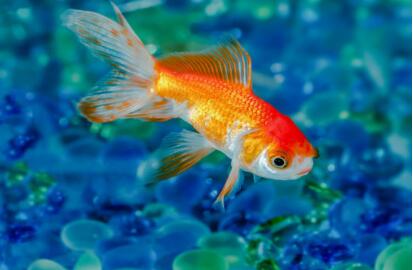
Peer into any fishbowl, and you'll see that pet goldfish and guppies have nimble fins. With a few flicks of these appendages, aquarium swimmers can turn in circles, dive deep down or even bob to the surface.
透過任何魚缸,我們都能看到金魚和孔雀魚那敏捷靈巧的魚鰭。只需輕輕擺動幾下魚鰭,這些魚缸里的“游泳好手”們就可以轉圈、深潛或直接浮上水面。
Nimble:敏捷、靈活、靈巧、機靈
Flick:輕拂、輕拍、輕彈
Appendage:附加物
New research led by the University of Colorado Boulder has uncovered the engineering secrets behind what makes fish fins so strong yet flexible. The team's insights could one day lead to new designs for robotic surgical tools or even airplane wings that change their shape with the push of a button.
由科羅拉多大學波爾得分校所牽頭的新研究已經發現了讓魚鰭如此強健但同時又十分靈活的工程學秘密。團隊的深入研究也許有一天可以創造出新設計的機器人外科工具或只需按下按鈕就可以改變形狀的飛機翅膀。
The researchers published their results Aug. 11 in the journal Science Robotics.
研究人員已于8月11日將研究成果發表在期刊《機器人科學》上。
Francois Barthelat, senior author of the study, noted that fins are remarkable because they can achieve feats of dexterity even though they don't contain a single muscle. (Fish move these structures by twitching sets of muscles located at the base of the fins).
研究資深作者Francois Barthelat強調表示,魚鰭令人驚嘆的原因是,即使沒有任何一塊肌肉,它們也具有了不起的靈活性。(魚兒通過猛拉位于魚鰭底部的肌肉組來移動這些結構)。
Twitch:急拉;猛拽;猛地被扯動
"If you look at a fin, you'll see that it's made of many stiff 'rays,'" said Barthelat, professor in the Paul M. Rady Department of Mechanical Engineering. "Each of those rays can be manipulated individually just like your fingers, but there are 20 or 30 of them in each fin."
“如果你仔細觀察魚鰭,你會發現它由許多不易彎曲的線組成,”Barthelat,機械工程Paul M. Rady系的教授表示。“每條線都可以單獨操控,就像人的手指一樣,每片魚鰭中有20或30條線。”
In their latest research, Barthelat and his colleagues drew on a range of approaches, including computer simulations and 3D-printed materials, to dive deep into the biomechanics of these agile structures. They report that the key to fish fins may lie in their unique design. Each ray in a fin is made up of multiple segments of a hard material that stack on top of much softer collagen, making them the perfect balance between bouncy and stiff.
在最新的研究中,Barthelat和他的同事利用一系列方法,包括機器人模擬和3-D打印材料,來深入了解這些靈巧結構內部的生物力學。他們報告說,魚鰭的關鍵可能在于其獨特的設計。魚鰭中的每條線都由許多個一段段的硬質材料組成,這些硬質材料堆疊在更加柔軟的膠原蛋白表面,使魚鰭在彈性和硬度之間達到了完美的平衡。
Draw on:利用
"You get this dual capability where fins can morph, and yet they're still quite stiff when they push water," he said.
“這種雙重能力使魚鰭可以改變形狀,但同時在推水時,又能夠仍然保持堅硬,”他表示。
Morph:變化、改變
Armor and airplanes
盔甲和飛機
Barthelat is no stranger to looking into aquariums. He previously studied how fish scales can help engineers to design better body armor for humans, and how seashells might inspire tougher glasses.
Barthelat對觀摩水族館并不陌生。他之前所研究的是魚鱗如何能夠幫助工程師為人類設計出更好的身體盔甲以及海貝殼如何能夠激發人們設計出更加堅固的眼鏡。
Aquarium:水族館
Fins may be just as useful. When it comes to engineering, Barthelat explained, materials that are both stiff and flexible are a hot commodity. Airplane designers, for example, have long been interested in developing wings that can morph on command, giving planes more ability to maneuver while still keeping them in the air.
魚鰭也許同樣有用。當涉及到工程學,Barthelat解釋道,既堅硬又靈活的材料非常搶手。比如,飛機設計師很早就有興趣設計出可以根據要求變形的翅膀,以使飛機在空中飛行的時候能夠更加靈活自如。
Just as:同樣,如同……那樣
on command:按照命令、按照指令
"Airplanes do this now, to some extent, when they drop their flaps," Barthelat said. "But that's in a rigid way. A wing made out of morphing materials, in contrast, could change its shape more radically and in a continuous manner, much like a bird."
“在某些程度上,當飛機降下襟翼時,它們可以實現靈活上下飛行。但是這是比較刻板的一種方式。由變形材料制作的飛機翅膀可以更加大幅度、連續地改變形狀,就像鳥兒一樣。”
Flap:襟翼
To understand how ordinary run-of-the-mill goldfish achieve similar feats every day, take a close look at these structures under the microscope. Each of the rays in a fin has a layered structure, a bit like a bakery éclair: The spikes include two layers of stiff and mineralized materials called hemitrichs that surround an inner layer of spongy collagen.
為了了解普通平凡的金魚如何擁有同樣類似的技能,我們來仔細觀察一下顯微鏡下的魚鰭結構。魚鰭中的每條線都是層疊結構,有點像面包師做的泡芙:尖頭部分包含兩層堅硬的礦物化材料,叫做半球,半球包裹著海綿膠原蛋白的內層。
run-of-the-mill:普通的、平凡的
But, Barthelat said, those layers of hemitrichs aren't solid. They're divided into segments, as if someone had cut up the éclair into bite-sized pieces.
但是,Barthelat表示,這些半球層并不是實心的。它們被分為各個弓形部分,就像有人將泡芙切成一口大小的小塊一樣。
bite-sized:一口大小的
"Until recently, the function of those segments hadn't been clear," he said.
“直到最近,這些弓形組成的功能都未得到明確了解,”他表示。
Swimming, flying and walking
游泳、飛翔和行走
The engineer and his team decided to use computer simulations to examine the mechanical properties of fins. They discovered that those segments can make all the difference.
工程師和他的團隊決定使用計算機模擬來檢查魚鰭的機械特性。他們發現,這些弓形組成發揮著巨大的影響力。
Pretend for a moment, Barthelat explained, that fish fins are made up entirely of collagen. They could bend easily, but wouldn't give fish much traction in the water because hydrodynamic forces would collapse them. Rays made up of solid, non-segmented hemitrichs, in contrast, would have the opposite problem -- they'd be way too stiff.
Barthelat解釋說,假設魚鰭完全由膠原蛋白構成,那么它們可以輕松彎曲,但是卻無法在水中給魚提供大部分牽引力,這是因為水動力會使它們瓦解。相反,如果線條由實心、非弓形的半球組成,那么就會有相反的問題-它們會變得過于堅硬。
way too:過于、簡直
"All of the segments, essentially, create these tiny hinges along the ray," Barthelat said. "When you try to compress or pull on those bony layers, they have a very high stiffness. This is critical for the ray to resist and produce hydrodynamic forces that push on water. But if you try to bend individual bony layers, they're very compliant, and that part is critical for the rays to deform easily from the base muscles."
“所有的弓形部分,基本上都沿著線條形成小的鉸鏈,”,Barthelat表示。“當你嘗試擠壓或拉扯這些骨頭狀的線條時,他們具有非常強的堅硬度。這對于線條阻擋并產生推動水的水動力至關重要。但是,如果你嘗試彎曲單個的骨狀線條,它們非常有韌性,這對于線條從底部肌肉處變形至關重要。”
The researchers further tested the theory by using a 3D printer to produce model fish fins made from plastic, some with those hinges built in and some without. The idea panned out: The team found that the segmented design provided better combinations of stiffness and morphing capabilities.
研究人員繼續利用3D打印機打印出用塑料制成的魚鰭模型來測試了這一理論,有些模型有內置的鉸鏈,有些則沒有。這個想法的結果是:團隊發現了半弓形設計能夠將堅硬度和變形能力更好地結合在一起。
Barthelat added that he and his colleagues have only scratched the surface of the wide diversity of fins in the fish world. Flying fish, for example, deploy their fins to glide above the water, while mudskippers use their fins like legs to walk on land.
Barthelat補充表示,在魚類世界種類多樣的魚鰭中,他和他的同事僅僅掀起了冰山一角。比如,飛魚會利用它們的魚鰭在水面上滑行,而彈涂魚的魚鰭就像腿一樣使其在陸地上行走。
scratched the surface:掌握了皮毛、蜻蜓點水
"We like to pick up where the biologists and zoologists have left off, using our background in the mechanics of materials to further our understanding of the amazing properties of the natural world," Barthelat said.
“我們想要了解生物學家和動物學家沒有涉及的領域,并利用我們在材料機械學方面的背景知識來進一步了解自然界令人驚奇的特性,”Barthelat表示。
來源:科學日報 編輯&翻譯:
譯銳翻譯Susan

